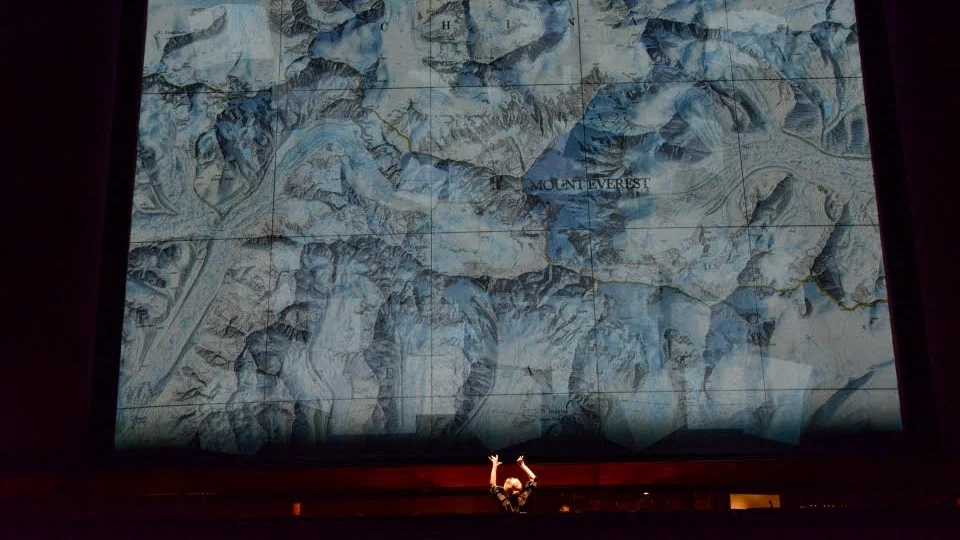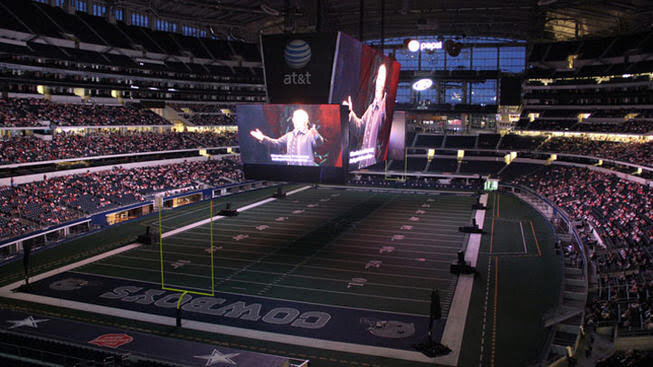Metropolitan Opera librarian Lionel Mapleson making cylinder recordings backstage at the Metropolitan Opera in 1901. Image Source: The Metropolitan Opera Archives.
If you think about technological innovation in the arts, opera is probably not the first thing to come to mind. However, history shows that opera has always pushed boundaries in finding creative new ways to produce extravagant productions. In the 1600s, opera theaters experimented with stage machinery, special effects and acoustic design. In the 1700s, the invention of electric lighting brought productions to new heights. Moving into the 1800s and 1900s, the invention of stereo sound transmission and radio broadcasts brought opera into people’s homes for the first time. As opera moved into the 21st century, digital technology launched the art form into a new sphere.
Former General Director of The Dallas Opera, Keith Cerny, identified “six technology trends that have opened significant creative opportunities for [the company]:
Exponential increase in computer processing power
More powerful projectors with lower cost
Digital photography, video and internet photo libraries, and public domain images
Satellite time as an inexpensive commodity
Fiber optic networks and Wave Division Multiplexing (WDM)
Recruiting talent and securing opera productions using Youtube.com and on-line searches.”
According to Cerny, the biggest impacts of these technological advances today are in the use of onstage projections, simulcast productions, as well as casting, production research and recruiting methods.
Technological innovation doesn’t end there though. Today, many opera companies are experimenting with newer technologies and methods, such as virtual reality, immersive theater, video games, augmented reality and 3-D sound. Composer Elizabeth Nonemaker notes that “Opera continues to be at the forefront of invention. As far as artistic directors are concerned, it’s all for the purpose of putting on a good show. But if the digital revolution has taught us anything, it’s that technological innovations carry the potential to transform our entire way of living, of thinking – our very culture.”
Screen projections from Everest at The Dallas Opera. Image Credit: Karen Almond.
A few examples of organizations who are breaking new ground in opera are Opera Philadelphia, BAM and San Diego Opera. Opera Philadelphia premiered “Denis & Katya” at Festival O19, which “tells the real-life story of Katya Vlasova and Denis Muravyov, 15-year-olds who ran away from their homes in Russia in 2016...staged a dramatic standoff with police and then died by apparent suicide” while live-streaming the entire ordeal on Periscope. “The staging features projected words, including comments from viewers on the original Periscope stream and, in a twist, real WhatsApp conversations between [the composer and director] discussing how to put on the very production the audience is watching.” BAM premiered “Oedipus: Sex with Mum” this month as well, an immersive opera that “mixes traditional performance with cutting-edge technology and emerging neuroscience…[to] turn the audience into the actual chorus of the opera.” The production also uses live augmented instruments. San Diego Opera developed a competition called Opera Hack with the goal of creating “innovative experiences for today’s opera-goers and to use technology to both reduce the cost of producing opera and to make collaborations between opera companies and designers easier” with the use of “VR and augmented reality, 3-D mapping, artificial intelligent machine learning and creative coding.” With organizations like these leading the way, it will be interesting to see who follows their lead and who blazes their own trail in the coming years.
Implementing creative technology into opera productions is one example of what Michael Kaiser calls a “transformational project,” one with “such scale and creativity that they change the way a community views an arts organization (The Cycle).” Additionally, Kaiser points out that it pays to think big. “Big projects are easier to fund and easier to sell than smaller ones.” As seen in the previous examples, technology can enable opera companies to set the art free through initiatives like simulcasts and streaming, let people in on the action with immersive and virtual reality techniques, be creative by presenting new works in new ways, as well as operating an arts organization and collaborating with other organizations in new ways, and cultivate a young and diverse audience (Recreating Fine Arts Institutions). “As both a tool and a topic, technology wields great influence on the arts, and opera is no exception. Operas that engage with technology — as an innovative performance method, a subject to explore, or both — have the potential to attract young, wired audiences.”
The Dallas Opera simulcast of The Magic Flute from AT&T Stadium - Image Credit: Luke McKenzie
Looking to the future, one thing is certain: digital technology is here to stay. Opera has always embraced innovation and spectacle, so it seems fitting that opera companies continue to embrace innovation in technology. The challenge will be staying true to the art form that audiences adore. Organizations like Philadelphia Opera, BAM and San Diego Opera have found ways to incorporate technology that complements the work rather than overpower it. Methods such as on-stage projections have become almost commonplace across the industry, allowing for more creativity and diversity in scene presentation. It will be interesting to see what other methods and techniques are developed and adopted in the years to come. Embracing technology will likely be a key factor in maintaining the art form in the future.
About the Author:
Sarah Simington is a Master of Arts Management student at Carnegie Mellon University.
Resources
Imam, James. “Technology and Opera.” The Cusp Magazine, May 24, 2016. https://thecuspmagazine.com/features/technology-and-opera-feature/.
Kaiser, Michael M., and Brett E. Egan. The Cycle: A Practical Approach to Managing Arts Organizations. Waltham, MA: Brandeis University Press, 2013.
Ragsdale, Diane E. “Recreating Fine Arts Institutions.” Stanford Social Innovation Review, 2009.
Shea, Andrea. “From Robots To Schoenberg: MIT Opera Of The Future Composer Tod Machover Evolves Tradition With Tech.” WBUR, November 14, 2018. https://www.wbur.org/artery/2018/11/14/from-robots-to-schoenberg-mit-future-of-opera-composer-tod-machover-evolves-tradition-with-tech.
Stearns, David Patrick. “Opera and Tech: The Met Ring and Beyond.” WQXR, April 2, 2019. https://www.wqxr.org/story/opera-tech-met-ring-beyond/.
Vincent, Caitlin. “Opera's Digital Revolution May Be the Key to Increasing the Artform's Appeal.” The Conversation, July 30, 2019. https://theconversation.com/operas-digital-revolution-may-be-the-key-to-increasing-the-artforms-appeal-100459




